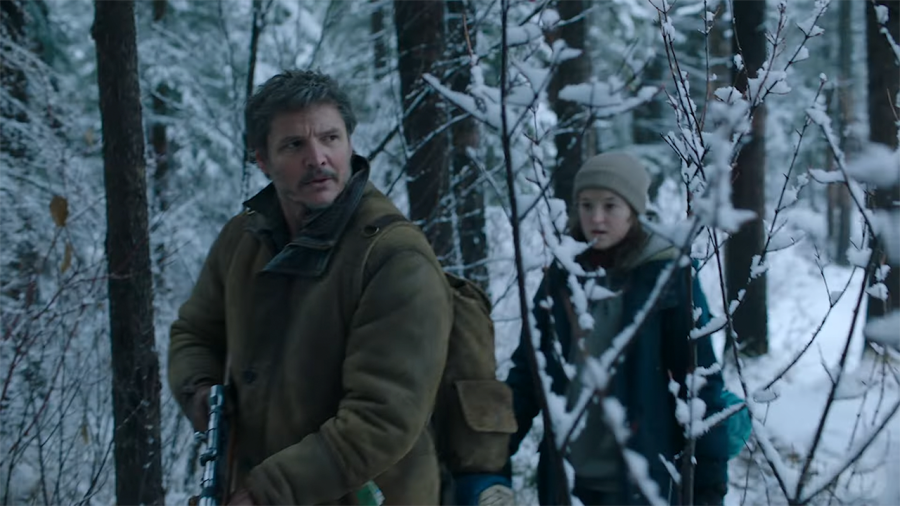HBO’s ‘The Last of Us’ captures the magic of the hit game
The show’s first three episodes have shown promise
Two characters from “The Last of Us’ travel through the snow.
February 1, 2023
When I purchased a PlayStation 3 long ago in the distant year of 2016, I made my first non-Pokemon or Mario video game purchase — a preowned copy of “The Last of Us.”
Or, at least, I attempted to. My best friend and I gathered at the back of the GameStop and counted my cash and coins down to the nickels in my wallet — only to be foiled during the moment of purchase when the attendant asked if I was over 17 years old. I did still get the game — but only after a walk of shame, a two-day long wait and a parent in tow when I returned.
Cue one of the most formative narrative experiences of my life.
“The Last of Us” is one of my top three games of all time, next to the likes of “Mass Effect 2” and “Red Dead Redemption.” To date, the sequel “The Last of Us II” is the only game I have ever preordered — a tall order for a cheap gamer like me, who would rather hold off playing something for two years rather than buy at full retail price.
I was delighted — but cautious — when the HBO Show was announced. After all, video games tend to have a terrible track record when adapted — especially to live-action. Still, I couldn’t stand to wait, so I ponied up the steep $15 HBO subscription fee to tune in.
At the time of my writing this, only the first three episodes have been released. Nevertheless, proceed with caution, because spoilers lie ahead for both the show and the games.
All three episodes, and the game, take place in post-apocalyptic America 20 years after the outbreak of the cordyceps fungal infection, which essentially renders its victims hyper-violent zombies — but with a few twists. In the show, protagonist Joel Miller (Pedro Pascal), a grizzled smuggler working out of fascist, post-apocalyptic Boston, is tasked with taking teenager Ellie Williams (Bella Ramsey) across the country to a research facility.
Though the show opens to a frankly uninspiring five minutes, things get rolling as soon as our real characters are introduced.
Sharp fans of the games will recognize scenes and dialogue lifted directly from the games — which are cleverly woven in rather than ham-fisted, as is often the case with adaptations. Watching the chaos of the outbreak from the backseat of a truck brought me back to my first playthrough, and Pedro Pascal’s reaction as Joel to an early tragedy is every bit as visceral in live action as game director Neil Druckmann portrayed.
The dialogue is delightful, especially the jokes. Perhaps I just have a particular sense of humor, but characters rarely made a snarky comment that fell flat. At times the exposition could feel a bit heavy, but that’s probably a consequence of my familiarity with the games rather than an issue for the average viewer.
Best of all, this format allows for the lore and characters to be deepened in new and exciting ways. We see the world through more than just Joel’s perspective, switching between characters across space and time, which enables the episodes to focus more on showing than telling. Combined with the excellent acting from all parties involved, it is incredibly hard not to get attached to the characters — even when I knew it was ill-advised.
Since television is basically nothing more than an extended cutscene, there are ample opportunities for cinematography. So far, the directors are taking advantage. Cue grim faces wandering in the dirty, dilapidated streets of the quarantine zone — scenes that are then juxtaposed with the verdant, bombed-out husk of Boston as nature reclaims what man has abandoned. Ethereal shots abound — tables are still neatly set in restaurants, but their champagne glasses are filled to the brim with moss. Something pounds ominous notes on a piano in a hotel-lobby-turned-swamp. A moment later, the camera pans to a frog hopping on the keys as baby ducks paddle in the background. The peace is beautiful yet haunting and palpably fragile, matching the tone of the games perfectly.
Even when the games’ lore is altered, it has been to a positive effect. The infected in the show adhere more strongly to the Rule of Cool — which says that audiences will often suspend disbelief if something looks cool — but feel more dangerous as a result. Unrestrained by coding constraints, they freely hurl themselves over tables and charge through furniture. Instead of producing contagious spore clouds, they have exploratory tendrils that can extend out of their mouth — a change that produced one of the most viscerally disturbing scenes I’ve ever seen. Further upping the stakes, a network of underground fungal tendrils means that one wrong step could alert dozens of infected people miles away to a character’s position.
Episode three had the sharpest divergences from the canon (spoilers ahead): Nick Offerman’s don’t-tread-on-me doomsday prepper Bill dies offscreen before Joel and Ellie arrive. But in exchange, the audience watches a sublime 20-year compilation of his life and heartfelt romance with fellow survivor Frank (Murray Bartlet), which might make the episode my favorite one so far.
Bill lives out a post-apocalyptic fantasy I imagine many of us share. He raids Home Depot for supplies, builds an electrified fence around his town, keeps electricity and hot water and, perhaps most importantly, steals a lifetime supply of wine from an abandoned local store. Still, his real joy in life doesn’t arrive until Frank shows up several years into the outbreak. The effect is like that of the first five minutes of the Pixar movie “Up” spread over 45 minutes.
While I do wish that Bill and Ellie had a chance to bicker onscreen — their dialogue was some of the best in “The Last of Us” — and that we could have seen the epic infected fight that happens in this portion of the game, I happily accept the changes and new stories being told. In fact, there hasn’t yet been a significant character that I didn’t want to spend more time with. This show recognizes that Joel and Ellie may be the beating heart of the story, but that doesn’t mean that they are the only ones with compelling stories to tell.
“The Last of Us” is about deeply flawed and morally suspect people, the worst of humanity and a world that probably can’t be saved — but it’s also a human story about the interludes of joy people find between the violence and the horror. As long as the show adheres to these guiding principles, I will happily be a passenger wherever Joel and Ellie’s journey takes us.















